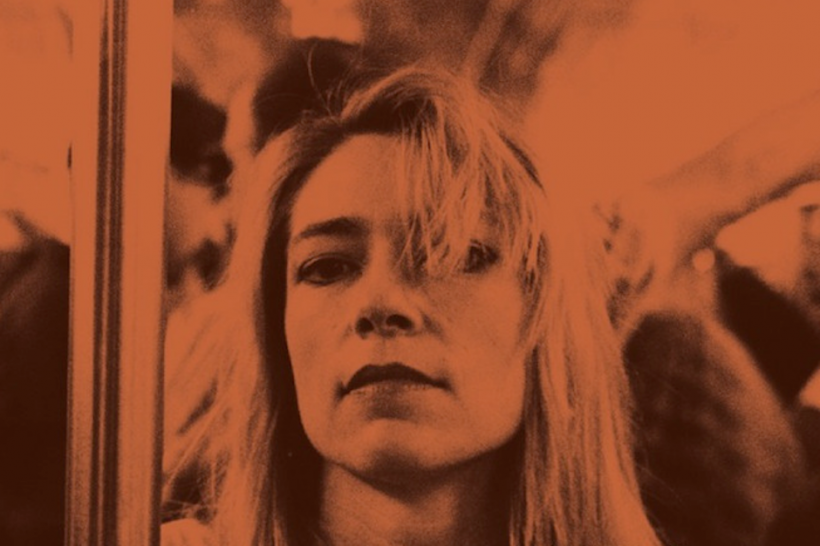When Kim Gordon comes to Seattle next Monday as part of the book tour for her forthcoming memoir, Girl in a Band, she’ll be speaking with Bruce Pavitt, who reviewed all of Sonic Youth’s early records in his Subterranean Pop fan zine. As we all know, the zine eventually morphed into one of the most successful independent record labels, ever; less known is that Pavitt says the band was instrumental to its launch.
“The very first album on Sub Pop was a compilation called Sub Pop 100,” he said recently, speaking near his home on Orcas Island. “When I decided to piece together the album, it featured a track by Sonic Youth called ‘Kill Yr Idols.’ [The band] was so revered at the time, I knew if I could get a Sonic Youth track it would help put it on the map. The record label owes the band a huge debt for helping to seed the very first album.”
Pavitt went on to become friends with Gordon, their lives intersecting through the years. It was at a place called Maxwells, in Hoboken, New Jersey, he remembers, when Gordon first saw Nirvana perform, at Pavitt’s suggestion. “Sonic Youth had a solid relationship with Seattle, with Mudhoney, and Nirvana,” he says. “There was a lot of dialogue between the two cities then.”
Pavitt recently published his own memoir, of sorts: Sub Pop USA: The Subterranean Pop Music Anthology, 1980-1988, a collection of his zines and related essays and columns about the music and bands he promoted during those years. Fresh from the tour circuit himself, Pavitt says he has some good questions and insights to bring to the conversation. “I have a pretty deep understanding of the scene she was a part of for many years,” he says.
He’s also a big fan of the rock memoir in general, and likens Gordon’s writing style to Patti Smith’s Just Kids. “They’re both New York-centric, bohemian memoirs,” he says. They’re books readers and music lovers find compelling because “they’re written by creative people. A creative, entrepreneurial person is someone who has developed their own system. Most people wake up, go to the office, and plug into a system. Kim has managed to create her own reality, and I think it’s really interesting how creative people work out of the system.”
With that in mind, we polled our contributors for their memories, thoughts, and recollections about what makes Kim Gordon the role model and icon she is. Don’t miss Gordon and Pavitt this Monday at the Neptune (
details here
), and read on for a few vignettes about one of the most influential bass players of her generation.
“During my moment to meet Kim Gordon, I had transformed into a grunting Beluga whale.”
Kim Gordon is an icon, a mix of feminism, fashion, and indie rock royalty. I’d been a fan for more than a decade when I first met her behind Caffe Vita the night Sonic Youth played Capitol Hill Block Party in 2009. My band was playing the same evening, and we were loading in our gear. Standing directly in front of me was one of my music idols, and here was an unexpected chance to meet her. Instead, my face went numb and my lips degenerated into some weird kind of spasm. I could hear a deep snorting sound that appeared to be coming from my mouth: During my moment to meet Kim Gordon, I had transformed into a grunting Beluga whale. Yet it was clear I was not the first person to become unhinged in her presence, as she waited patiently for my lips to utter words from the English language. When none came, Thurston Moore came over, and the rest of the band whisked her away. Soon I was alone, standing there with my guitar case. Life is funny. DAVE EINMO
In 1993, I knew Sonic Youth through Daydream Nation, Goo, and Dirty, albums which were just then being discovered and shared within my group of “alternative” high school friends. These records were insane to me back then, almost incomprehensible, jangled and crunchy, nothing like the pop and country I was weaned on. Yet even as I digested them, I came to know a parallel storyline, unrelated to the music: Kim Gordon was five years older than Thurston Moore. Flash forward to Capitol Hill Block Party 2009: Kim is 56, the narrative reminds us—not a fresh faced rocker but a seasoned veteran of the indie stage—and she looks amazing, sporting that platinum hair and a terrific gold jumpsuit. I’m towards the middle back of the crowd, by Neumos, and the band is a blur, hard to see—except for Kim, a shimmering, metallic, electric entity. Somehow a woman’s age always makes it into the story, but when it does, it’s never more rewarding to see someone like Gordon honor it with the distinction it deserves: adorned in dazzling color, rock-steady behind her instrument, every brooding, chugging tone the sound of someone who earned every year. GWENDOLYN ELLIOTT
Before Kurt Cobain broke out of Aberdeen, Kim Gordon was the original negative creep. This was never made more obvious than last year when she fronted Nirvana during “Aneurysm” at the 2014 Rock & Roll Hall Of Fame Induction Ceremony. She didn’t so much sing the song but growled and hissed it, spinning around stage in a striped dress and silver heels, swinging the microphone with wild abandon. In her performance, she conveyed the same sense of rashness and dissatisfaction that Cobain, perhaps first taking his cues from her, also embodied. Near the end, when she fell to her knees and screamed, “She keeps it pumpin’ straight to my heart!,” Gordon was the flesh incarnate of those lyrics. She was volatile. She was menacing. She was punk. DUSTY HENRY
Kim Gordon has a keen eye for talent. For better or worse, we have her to thank for introducing the world to Courtney Love. A major Sonic Youth fan, Love petitioned Gordon to produce Hole’s debut album, Pretty on the Inside, and though Gordon initially declined, Love was persistent. “I had a feeling she asked me only because she wanted my name associated with the record,” Gordon writes in her new book. “She was the kind of person who spent a lot of time growing up staring in the mirror practicing her look. But she had a great punk rock voice, and the song titles and lyrics were pure provocation.” Gordon eventually agreed to come on board and they made the record in a single week. It remains Love’s most incendiary work—a noisy, raging manifesto that hints at the more well-crafted material that would follow, even if Love has described it in recent years as “unlistenable.”
We can also thank Kim Gordon for introducing the world to filmmaker Spike Jonze, who, in addition to directing Being John Malkovich and Her, also helped create the Jackass series. Before any of that, Gordon and Jonze co-directed the music video for The Breeders’ 1993 single, “Cannonball,” which features both Kim Deal singing underwater and a run away cannonball. “Spike Jonze was a little skater boy that Kim Gordon knew,” The Breeders’ Kelley Deal told Seattle Weekly. “She was the director but by the end of it he was so instrumental with his vision and the cool stuff that he was able to get that she ended up doing a co-director thing with him.” NME named the video one of its 100 greatest of all-time. DAVE LAKE
“The breakup of rock’s most perfect union only served to further advance my hypothesis that ‘true adult love’ was a total myth.”
When my mom started going through a divorce in 2011, I experienced all the blows with her. We cried together, grasped at straws together, felt lost and confused together. Kim Gordon (also a mom) announced her infamous split later that same year, owing to Thurston Moore’s secret affair. As goofy as it sounds, the breakup of rock’s most perfect union only served to further advance my rapidly developing hypothesis that “true adult love” was a total myth, as mangled as one of Sonic Youth’s screwdriver guitars. When a marriage forms the foundation for so much—whether within a pioneering noise band, or in my mother’s case, a family—confronting a future void of that is almost incomprehensible at first. In the same way Gordon’s divorce initially reinforced my disbelief in “love,” watching her come out of it and somehow double down on what made her impossibly cool before it all went down has only reinforced how much I love my mother, who I’ve dumbfoundedly watched pull off the same feat. A recent New York Times profile on Gordon ends with a sentiment from the artist that’s similar to something my mother’s been echoing recently: “For a while, I was concerned about being alone. Now I’m really enjoying my freedom.” Leave it to Kim Gordon to show me how something totally atonal can turn into something beautiful. KELTON SEARS
I only saw Sonic Youth once and, admittedly, after they—and I—had gotten a bit long in the tooth. Still, I was super excited to see the band live, outdoors, in Battery City Park in New York City on a hot, sunny July Fourth in 2008, with the Feelies opening. What I remember most, besides the super-loud, super-charged show, was a funny, endearing moment on stage when Kim Gordon forgot the lines to a song, its name which escapes me now. She just kind of started singing nonsense and then Thurston Moore took over until the words came back to her. He made a joke about it, and everyone laughed. For me, it really solidified the pair not just as longtime band mates, but as a husband and wife team. It seemed like the kind of funny, sweet thing that happens in marriages all the time—she forgets part of a story, he finishes the sentence—but all the more ironic between members of a post-punk band. NICOLE SPRINKLE
It was July Fourth 1992 in Central Park. There was lots of humidity but we didn’t care because it was such a great line-up: Sun Ra and Sonic Youth. To make matters worse, as we stood in line it began to rain. We contemplated sneaking in, but how? There were fences everywhere. It continued to rain once we got in, and on throughout the Sun Ra set. We couldn’t buy beer because we didn’t have ID. This sucked, standing in the rain with our shirts stuck to our backs and no booze. After Sun Ra played some crazy sets in equally crazy costumes, we moved up to the front of the stage and waited for Sonic Youth. The rain didn’t stop, but we’d given up being annoyed—I remember looking at each other’s hair and laughing. Sonic Youth finally came on and started playing something from Dirty, its new album. At that moment the sun began to peak through and, by the middle of their set, our clothes began to dry. To go from disastrous jungle-like weather to mild and sunny was very rare for the city. Maybe it was Sun Ra, who would pass away the next year, summoning his interplanetary powers; but I’m convinced it was all that great music. JOSE TRUJILLO




